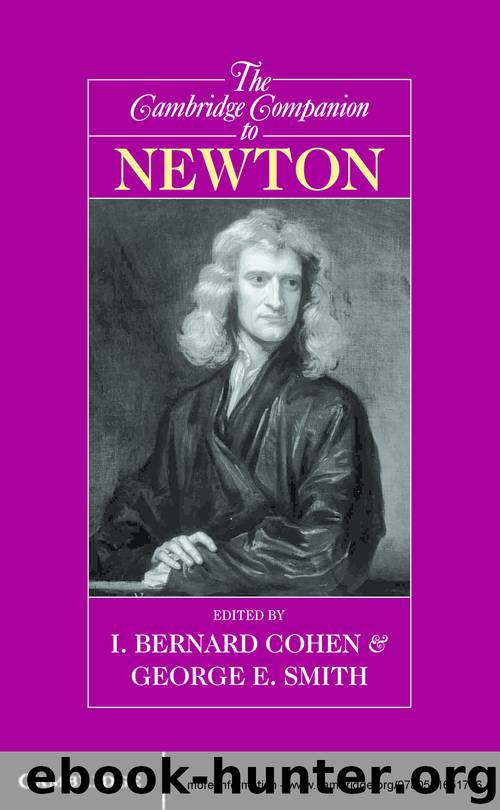The Cambridge Companion to Newton by I. Bernard Cohen & George E. Smith

Author:I. Bernard Cohen & George E. Smith [Cohen]
Language: eng
Format: epub
Publisher: Cambridge University Press
Published: 2013-01-31T05:00:00+00:00
Newton explains that in saying that a body fills (Latin: implet) a space, he means to imply “so fully occupies it as utterly to exclude other things of the same kind (other bodies) as if it were an impenetrable thing.” Why, one may ask, “as if”? Does not a body’s exclusion of other bodies mean that it is an “impenetrable thing”? The answer to this emerges later: Newton believes that minds, as well as bodies, have their definite places in space; and he believes that bodies and minds can occupy the same – or overlapping – places; so bodies are not absolutely impenetrable, but are so only to one another.
After a few further preliminary clarifications, Newton calls attention to the fact that in these definitions he has departed fundamentally from the doctrines of the Cartesians: both in distinguishing between space and bodies, and in that he has “determined motion with respect to the parts of that space, not with respect to the positions of the contiguous bodies.” It is this remark that leads to the metaphysical digression, in which Newton is concerned, first, to refute the theory of space and motion of Descartes’s Principles of Philosophy; then to present his own conception of the nature of space (and, with less elaboration, of time); finally – and with greatest originality – to present his conception of the nature of body – how it is related to, and how distinguished from, space.
The refutation of Descartes on place and motion has two main parts. In the first, Newton argues that Descartes himself, in the development of his physics in Parts 2 and 3 of his Principles, proceeds in a way that is inconsistent with his own theory of motion, and thus “seems to acknowledge” its inadequacy. Since we are not here primarily concerned with Descartes, one example may suffice – the one that is most directly connected with Newton’s evidence for the view he himself favors. According to Descartes, the earth – and, indeed, each of the planets – is, “if we are speaking properly and according to the truth of the matter” (Newton paraphrases the second phrase as “according to the philosophical sense”), not moved, but rather at rest; since each of these bodies, according to Descartes’s theory of the planetary system, is carried around the sun by a material vortex: each planet, then, is at rest relative to the bodies that immediately surround it, and is therefore at rest in the “proper” sense of the word.28 This is the basis of Descartes’s claim that his view in the Principles is immune to the charge of attributing motion to the earth. But, Newton points out, in his dynamical theory of the planetary system Descartes attributes to the planets a tendency to recede from the Sun on account of their motion around it. So in developing the principles of his philosophy Descartes makes use of a conception of motion that is not the one he puts forward as “proper and according to the
Download
This site does not store any files on its server. We only index and link to content provided by other sites. Please contact the content providers to delete copyright contents if any and email us, we'll remove relevant links or contents immediately.
The Complete Stick Figure Physics Tutorials by Allen Sarah(7133)
Secrets of Antigravity Propulsion: Tesla, UFOs, and Classified Aerospace Technology by Ph.D. Paul A. Laviolette(4970)
Thing Explainer by Randall Munroe(3780)
The River of Consciousness by Oliver Sacks(3406)
The Order of Time by Carlo Rovelli(3070)
How To by Randall Munroe(2910)
I Live in the Future & Here's How It Works by Nick Bilton(2837)
A Brief History of Time by Stephen Hawking(2816)
What If?: Serious Scientific Answers to Absurd Hypothetical Questions by Randall Munroe(2542)
The Great Unknown by Marcus du Sautoy(2531)
Midnight in Chernobyl by Adam Higginbotham(2380)
Blockchain: Ultimate Step By Step Guide To Understanding Blockchain Technology, Bitcoin Creation, and the future of Money (Novice to Expert) by Keizer Söze(2377)
Networks: An Introduction by Newman Mark(2263)
The Meaning of it All by Richard Feynman(2211)
Easy Electronics by Charles Platt(2204)
The Tao of Physics by Fritjof Capra(2160)
Midnight in Chernobyl: The Untold Story of the World's Greatest Nuclear Disaster by Adam Higginbotham(2070)
When by Daniel H Pink(2019)
Introducing Relativity by Bruce Bassett(2014)
